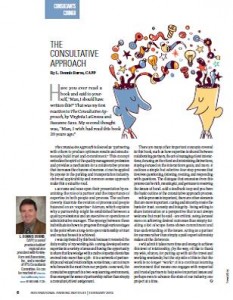Have you ever read a book and said to yourself, “Man, I should have written this!” That was my first reaction to The Consultative Approach, by Virginia LaGrossa and Suzanne Saxe. My second thought was, “Man, I wish had read this book 20 years ago.”
The Consultative Approach is defined as “partnering with others to produce optimum results and simultaneously build trust and commitment.” This concept embodies the spirit of the quality management profession and provides a mechanism for a collaborative process that increases the chances of success. It can be applied by anyone in the parking and transportation industry. Its broad applicability and common-sense approach make this a valuable read.
LaGrossa and Saxe open their presentation by examining the role of a partner and the importance of expertise in both people and process. The authors cleverly illustrate the relation of process and people balanced on an “expertise” fulcrum, which explains why a partnership might be established between a quality professional and an executive or operations or administrative manager. The synergy between these individuals is shown to progress through various stages to the point where a long-term open relationship of trust and mutual benefit is achieved.
I was captivated by this book because it reflected the daily reality of my working life. Having developed some expertise in a variety of areas and having the opportunity to share that knowledge with a cadre of special clients has evolved into more than a job—it is a network of partnerships and valued relationships. Sometimes, I am not sure who benefits the most from our projects. Done well, the consultative approach is a two-way learning environment; thus emerges the sense of partnership rather than simply a consultant/client assignment.
There are many other important concepts covered in this book, such as how expertise is shared between collaborating partners, the art of managing client interactions, focusing on the client and minimizing distractions, staying focused on the interaction’s goals, and more. It outlines a simple but effective four-step process that involves questioning, listening, refining, and responding with questions. The dialogue that emanates from this process can be rich, meaningful, and germane to resolving the issues at hand. Add a feedback loop and you have the basic outline of the consultative approach process.
While process is important, there are other elements that are more important. Caring and sincerity create the basis for trust. Honesty and integrity—being willing to share information or a perspective that is not always welcome but must be said—are critical. Being focused more on achieving desired outcomes than simply fulfilling a list of scope items shows commitment and true understanding of the issues. Acting as a partner for success rather than simply a paid expert ultimately makes all the difference.
I will admit it takes more time and energy to achieve this level of relationship, (by the way, I’d like to thank my wife, Sharon, for putting up with all the travel and working weekends) but the flip side of this is that the work is no longer “work.” It is a continual learning environment that means one engages with respected and trusted partners to help solve important issues and perhaps even to advance the state of our industry, one project at a time.
L. Dennis Burns, CAPP, is senior practice builder/regional vice president with Kimley-Horn and Associates, Inc., and a member of IPI’s Consultants Committee. He can be reached at dennis.burns@kimley-horn.com or 602.906.1125.
TPP-2013-02-The Consultative Approach

